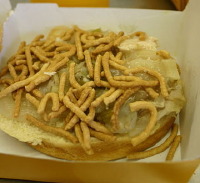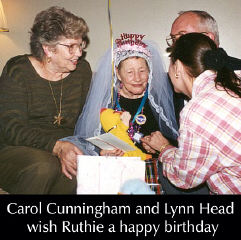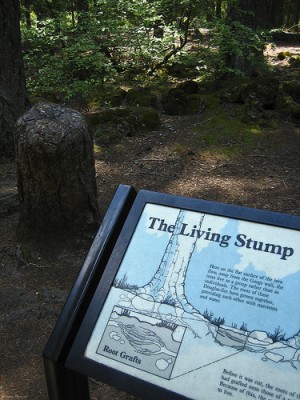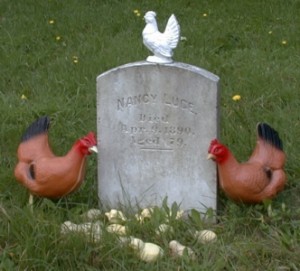Regionalism
German Humor
Some might regard the phrase "German sense of humor" as an oxymoron. Nevertheless, the Caricatura Museum, recently opened in Frankfurt, is dedicated to exploring exactly that subject. According to the Telegraph:It's first event: a Mohammed lookalike competition.
Posted By: Alex - Tue Oct 28, 2008 -
Comments (2)
Category: Humor, Regionalism
Lost in Translation
I'm posting this from a Starbucks in Bremen, Germany. (I'd prefer to be in a German cafe, but Starbucks turns out to be the easiest place to find an internet connection.)


Posted By: Alex - Mon Oct 27, 2008 -
Comments (2)
Category: Regionalism, Signage, Travel
Chow Mein Sandwiches

Chow Mein Sandwiches are a Fall River specialty, and there's not many other places you can find them. Even in Fall River, they're becoming increasingly rare. According to Flavor & Fortune magazine, a Chow Mein Sandwich is:
The key is that the noodles have to be crunchy. In other words, you can't slop Chow Mein from your local Chinese restaurant on a bun and expect it to taste like a real Chow Mein Sandwich. If you want to try one, and you don't live in New England, your only option seems to be to mail-order the "Original Hoo Mee Chow Mein Mix" from the Oriental Chow Mein Company in Fall River, and prepare your own.
The thumbnail is from Wikipedia.
Posted By: Alex - Sun Oct 12, 2008 -
Comments (1)
Category: Food, Regionalism
Babies On Parade
How did this fabulous event ever come to cease?
Posted By: Paul - Tue Sep 30, 2008 -
Comments (10)
Category: Babies, Games, Parades and Festivals, Regionalism, 1950s
Tiger Trouble
So far as I can tell, the tiger stalking Galveston is still on the loose. But the Galvestonians could have it much worse. Consider the plight of the citizens of the Sundarbans in India.I first learned of the reign of man-eating tigers here ten years ago, watching this series of PBS's NATURE show. One episode revealed how the natives had to wear human face masks on the backs of their heads to avoid tigers pouncing on them and eating them. (It was not a totally successful tactic.) I believe this bit later showed up in the wonderful Calvin and Hobbes strip, with Calvin trying the same tactic to avoid Hobbes's attacks.
This photographer, who goes by the handle of Jimbojack, has some wonderful photos of the region for you to look at.
Posted By: Paul - Sun Sep 21, 2008 -
Comments (5)
Category: Animals, Death, Regionalism, Television, India
Ruth Grace Moulon, RIP

Ruthie the Duck Girl was a New Orleans character famed for her pet ducks. You can read her history at the intriguing site known as ECCENTRIC NEW ORLEANS, and then read her LOS ANGELES TIMES obituary here.
A documentary was made about her, and shown on WYES TV, but I can't find any online video of it.
Posted By: Paul - Tue Sep 16, 2008 -
Comments (0)
Category: Animals, Celebrities, Death, Obituaries, Eccentrics, Pets, Regionalism
The Living Stump
On my recent trip to Oregon, I stopped at the Rogue River Gorge. And there I saw...THE LIVING STUMP!
I did not snap a picture, but fortunately I could borrow one from El Sylvan's Flickr set.
The Living Stump is the remnant of a tree whose roots became symbiotically intertwined with a neighboring tree. So that when one tree was cut down, the partner tree continued to nourish the stump, which did not decay as any other chopped-down tree might be expected to.
Yes, folks, this is A ZOMBIE TREE!
Posted By: Paul - Sat Sep 13, 2008 -
Comments (3)
Category: Celebrities, Death, Nature, Photography and Photographers, Regionalism
Nancy Luce, Chicken Lady of Martha’s Vineyard
A few years ago, visiting the island of Martha's Vineyard off the Massachusetts coast, I learned of Nancy Luce (1814-1890). An eccentric loner artist who self-published her own poetry--mainly devoted to her beloved pet chickens--and buried the birds with fully engraved headstones, she is the subject of a biography still available on the island at various gift shops: Consider Poor I by Walter Magnes Teller. You can read what The New York Times had to say about the book here. You might even be so moved as to purchase a lovely woodcut print of Luce here.POOR LITTLE HEARTS
Poor little Ada Queetie has departed this life,
Never to be here no more,
No more to love, no more to speak,
No more to be my friend.
O how I long to see her with me alive and well,
Her heart and mine was united,
Love and feelings deeply rooted for each other,
She and I could never part,
I am left broken hearted....
Posted By: Paul - Wed Sep 10, 2008 -
Comments (10)
Category: Animals, Domestic, Eccentrics, Literature, Books, Writers, Regionalism, Nineteenth Century
The South Will Collect Its Pensions Again!
Posted By: Paul - Mon Aug 25, 2008 -
Comments (3)
Category: Animals, Death, Obituaries, History, Historical Figure, Hollywood, Literature, Books, Regionalism, War, Cartoons, Marriage
On the Nod

When you wake up after trying this, please report back to WU Central with the results.
Posted By: Paul - Sun Aug 24, 2008 -
Comments (15)
Category: Business, Products, Drugs, Inebriation and Intoxicants, Regionalism

| Who We Are |
|---|
| Alex Boese Alex is the creator and curator of the Museum of Hoaxes. He's also the author of various weird, non-fiction, science-themed books such as Elephants on Acid and Psychedelic Apes. Paul Di Filippo Paul has been paid to put weird ideas into fictional form for over thirty years, in his career as a noted science fiction writer. He has recently begun blogging on many curious topics with three fellow writers at The Inferior 4+1. Contact Us |







